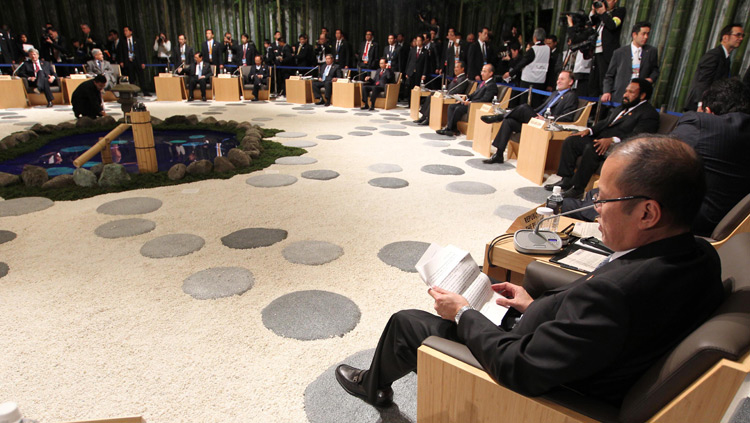Aquino fumes, 6
countries told
to explain decision
MANILA — The embassies in Manila of the United States, Australia, New Zealand, and the United Kingdom have expressed that their respective recent travel advisories on the Philippines have “not changed” for the worse since a year ago, contrary to perceptions in the media.

YOKOHAMA – Philippine President Benigno Simeon Aquino III joins 20 heads of state and government at the Leaders’ Retreat Session 1 with the theme “Sustaining Growth and Prosperity in the Region” Saturday (Nov. 13) at the Intercontinental Yokohama Grand Hotel at the 18thAsia Pacific Economic Cooperation (APEC) Leaders’ Meeting in Yokohama from November 12-14, 2010. (Photo by: Ryan Lim/ Malacañang Photo Bureau).
According to the Department of Foreign Affairs (DFA), the four foreign embassies gave assurance that their “assessment of the level of threat in their travel advisories on the Philippines has not changed and remain the same as before.”
The travel advisories generally asked their respective citizens to be aware of some danger in parts of the Philippines and to refrain from visiting those areas, if possible.
Australia, for example, includes warnings against landslides and typhoons and the possibility of being stranded in places because of inadequate inter-island transportation during the monsoon season.
DFA spokesperson Eduardo J. Malaya said the four embassies were responding to an earlier note verbale DFA had sent them separately in which it sought clarification on their travel advisories that were interpreted and reported by the press as tending to be alarmist.
Malaya said that the note verbale “reiterated the request for an expedited sharing of any information on possible terrorist threat.”
“The central challenge is to give all the information necessary to protect the public and at the same time try not to frighten people unreasonably,” Malaya said on Sunday, at the height of the news uproar.
“Filipinos can go about their business normally, with the knowledge that our police and security agencies are hard at work,” he added.
The DFA also wrote to the French and Canadian embassies about their own travel advisories but both have apparently not yet responded as of press time.
Last week, the foreign ministries of the six countries “issued travel advisories on the Philippines due to information of a heightened risk of a terrorist attack in the country,” according to Malaya.
Concerned, President Benigno Aquino III instructed that an inquiry be made with the embassies, Malaya said.
The DFA quoted US Ambassador Harry Thomas as saying, “I feel safe traveling in the Philippines.”
Thomas is scheduled to travel to Bacolod City on Friday to swear in 71 new volunteers of the US Peace Corps who will serve in the Visayas Region. Another 66 volunteers will be dispersed in northern Luzon.
”In the case of the Philippines, the United States does not advise its citizens against visiting any part of the country. We do, however, have a responsibility to warn our citizens about the risks in certain places and to urge them to consider this information carefully when deciding whether or not to travel,” the US embassy said on Wednesday afternoon in a separate information to the press.
The embassy noted that on any given day, 250,000 Americans are in the Philippines. It pledged to ”continue to work together against terrorism by training Philippine security forces, providing equipment and sharing information on potential threats. Our mutual efforts have contributed to significant successes in protecting Filipino and US citizens.”
It clarified that US travel warnings are normally updated twice a year, the most recent being that issued on November 2 which it said varies only slightly from that issued six months ago.
”All our recent travel warnings note that terrorism can occur anywhere in the world. We have had a travel warning in effect for the Philippines since at least 2005 and the updated travel warning does not reflect a change in alert status,” the embassy continued.
As to the UK, its Foreign and Commonwealth Office (FCO) informed the Philippine Embassy in London on November 3 that “it did not issue a new travel advice, but rather only added a minor sentence” with regard to some places where terrorist attacks may occur.”
FCO stressed “its assessment of the overall level of threat … has not changed for over a year already,” as it underscored that its travel advices needed to be “accurate” but also “sensitive to the needs and perspective of the Philippines.”
The Australian and New Zealand Embassies responded to the DFA’s note verbale in a similar tone, Malaya noted.
In its reply note on November 9, the Australian embassy here said that “the travel advisory for the Philippines reflects the Australian government’s understanding of the risks faced by Australians in the Philippines at this time.”
The embassy added that “Australia reissued its travel advisory for the Philippines to convey new information, although the overall level of travel advice did not change.”
“All Australian travel advisories, including our travel advice to the Philippines, are kept under constant review and updated promptly to reflect new information or in response to changes in the safety and security environment,” it added.
Also in a November 9 note, the New Zealand embassy said that its latest periodic advisory conveyed that “…the overall level of risk was not changed.”
“New Zealand issues travel advice to its citizens in respect of most countries in the world, and updates this advice periodically,” it said.



 ShareThis
ShareThis